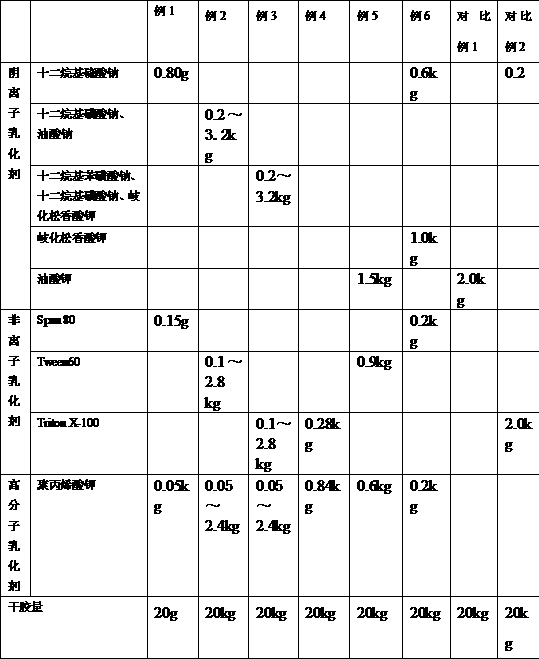Production method of artificial latex
A production method and technology of artificial latex, which is applied in the field of artificial latex, can solve problems such as excessive foaming, and achieve the effects of excellent physical properties, controllable structure, and high cis content
- Summary
- Abstract
- Description
- Claims
- Application Information
AI Technical Summary
Problems solved by technology
Method used
Image
Examples
example 1
[0021] Weigh 20g of isoprene rubber and dissolve it in 180g of cyclohexane to prepare a 10 wt% rubber solution; dissolve 0.80g of sodium lauryl sulfate, 0.15g of Span 80 and 0.05g of potassium polyacrylate in 150g of deionized water and use Potassium hydroxide is used to adjust the pH value within the range of 9 to 13; the rubber solution and emulsifier aqueous solution are poured into a round-bottomed flask for strong mechanical stirring to form a macroscopically homogeneous mixed solution. The pre-emulsified emulsion was first emulsified with a high-speed emulsifier at a line speed of 10m / s for 5 minutes, and then emulsified at a line speed of 16m / s for 10 minutes, then left to stand for 3 hours and then filtered to remove the floating matter in the upper layer. Distill the emulsified emulsion at 30-90°C under atmospheric pressure, wait until 80% (most) of the solvent is removed, and then carry out vacuum distillation at a temperature of 30-90°C and a pressure of -0.01- -0.1M...
example 2
[0023] First take 18-20 kg of butadiene rubber and dissolve it in 180-190 kg of benzene to prepare a rubber solution; 0.2-3.2 kg of sodium dodecylsulfonate and sodium oleate as anionic emulsifiers account for half of each Mix in a ratio of 1, dissolve 0.1-2.8 kg of polyoxyethylene (20) sorbitan monostearate (Tween60) as a non-ionic emulsifier and 0.05-2.4 kg of potassium polyacrylate as a polymer emulsifier in 150-160 kg of deionized water and adjust the pH value to 9-13 with potassium hydroxide to make an aqueous emulsifier solution; pour the above-mentioned rubber solution and emulsifier aqueous solution at a ratio of 1:0.5-2.0 parts by weight at the same time and stir Perform strong mechanical stirring in the device to form a macroscopically homogeneous pre-emulsified mixed solution; the pre-emulsified emulsion is first emulsified with a high-speed emulsifier at a line speed of 10m / s for 5 minutes, and then emulsified with a line speed of 16m / s for 10 minutes, and then stati...
example 3
[0025] Dissolve 18-20 kg of isoprene rubber in 180-190 kg of cyclohexane to prepare a rubber solution; add 0.2-3.2 kg of sodium dodecylsulfonate and dodecylbenzenesulfonate as an anionic emulsifier Sodium abietate and potassium disproportionated abietate accounted for one-third of each, mixed with 0.1-2.8 kg of polyoxyethylene (8) octyl phenyl ether (Triton X-100) as a non-ionic emulsifier and 0.05- Dissolve 2.4 kg of potassium polyacrylate as a polymer emulsifier in 150-160 kg of deionized water and adjust the pH value to 9-13 with potassium hydroxide to make an aqueous emulsifier solution; mix the above rubber solution and emulsifier aqueous solution with 1 : 0.5 to 2.0 parts by weight and pour into the mixer for strong mechanical stirring to form a macroscopically homogeneous pre-emulsified mixture; the pre-emulsified emulsion is first emulsified with a high-speed emulsifier at a line speed of 10m / s for 5 minutes, and then Emulsify with a linear speed of 16m / s for 10 minutes,...
PUM
 Login to View More
Login to View More Abstract
Description
Claims
Application Information
 Login to View More
Login to View More - R&D
- Intellectual Property
- Life Sciences
- Materials
- Tech Scout
- Unparalleled Data Quality
- Higher Quality Content
- 60% Fewer Hallucinations
Browse by: Latest US Patents, China's latest patents, Technical Efficacy Thesaurus, Application Domain, Technology Topic, Popular Technical Reports.
© 2025 PatSnap. All rights reserved.Legal|Privacy policy|Modern Slavery Act Transparency Statement|Sitemap|About US| Contact US: help@patsnap.com

